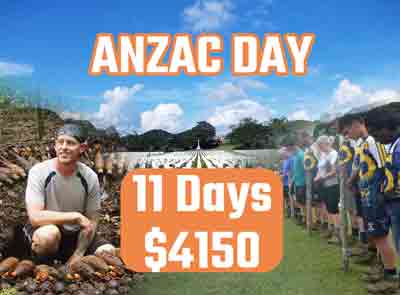Australian History 1942: Exploring the Battle of Wau in Papua New Guinea
Introduction
As avid trekkers gear up for the challenging but rewarding experience of hiking the renowned Kokoda Track, it is essential to delve into the historical events that unfolded in the Papua New Guinea region. One significant chapter in the Pacific War that holds a connection to the Kokoda Campaign is the Battle of Wau. This article will guide you through the pivotal moments, key battles, and the strategic significance of Wau in the early 1940s.
Background: The Kokoda Campaign
The Kokoda Track, nestled within the Owen Stanley Range, became a crucial theatre during the Pacific War. The Australian Army, faced with the Japanese advance, engaged in a series of battles and campaigns to defend the territory of New Guinea. The trekking path, once a line of communications to Wau, witnessed the valiant efforts of Australian forces against the Japanese onslaught.
The Strategic Importance of Wau
Wau, a town located in the New Guinea region, occupied an important place in the strategy of both the Australian and Japanese forces. Its significance lay in its airstrip, which played a pivotal role in facilitating military movements and supplies. As the Japanese sought to advance on Wau, the Australians recognized the need to defend this key position to maintain their line of communications.
The Battle Unfolds: 1942-1943
Japanese Advance on Wau
In June 1942, the Japanese forces made their move towards Wau, choosing it as a target for its strategic importance. The town, with its airfield, became a focal point for the ensuing conflict. The Australian forces, stationed at Milne Bay, recognized the impending threat and chose to advance on Wau to thwart the Japanese plans.
Australians Defend Wau
By January 4, 1943, the Australians, determined to defend Wau, engaged in fierce battles against the Japanese. The rugged terrain, including the Bulldog Track, became witness to the clashes between the Australian and Japanese forces. The Battle of Wau saw intense fighting as the Australians repelled Japanese attacks, holding their ground against mortar and machine gun assaults.
Relief Efforts and Evacuations
Amidst the turmoil, the Australians initiated relief efforts, flying in supplies and reinforcements to support the defenders at Wau. Evacuations were also carried out, ensuring the safety of civilians, including women and children, who were relocated from areas like Lae and Salamaua to safeguard them from the horrors of war.
Turning the Tide: Australian Success
Beating the Japanese to Wau
Despite the challenges, the Australians succeeded in beating the Japanese to Wau. Through strategic planning and determined efforts, they managed to quickly capture Wau on the third attempt. This victory not only secured the town but also disrupted Japanese plans for further advances in the region.
Allied Air Support
The Australians benefited from crucial air support, with aircraft bombing the Wau airstrip and thwarting Japanese attempts to strengthen their position. The successful coordination between ground forces and air support played a pivotal role in the Australian triumph at Wau.
Legacy of the Battle of Wau
The Battle of Wau, part of the larger New Guinea campaign, left an indelible mark on the history of the Pacific War. The town of Wau, once a battleground, is now a site for reflection and remembrance. Trekkers on the Kokoda Track can witness firsthand the terrain where Australian forces stood firm against the Japanese advance, securing a significant victory.
Conclusion
As trekkers embark on the challenging journey of hiking the Kokoda Track, understanding the historical context adds depth to the experience. The Battle of Wau, with its strategic significance and the valiant efforts of the Australian forces, remains a testament to the resilience and determination displayed during the Pacific War. As you trek through the Owen Stanley Range, let the echoes of history guide your steps, reminding you of the sacrifices made in the pursuit of freedom.
FAQ’s
Q: What was the Battle of Wau in Papua New Guinea?
A: The Battle of Wau was a significant battle that took place in January 1943 during World War II, as part of the New Guinea campaign. It was fought in the Wau area of Papua New Guinea, where Australian forces defended against Japanese troops.
Q: When did the Battle take place?
A: The Battle of Wau occurred in January 1943, with the Australian forces successfully resisting the Japanese attempt to capture the town.
Q: What was the significance of Wau during the battle?
A: Wau was strategically important as it served as a crucial hub for the Allies, providing a vital airfield and communication links in the region. Its capture by the Japanese would have been detrimental to Allied operations in the area.
Q: What were the key events leading up to the Battle?
A: In August 1942, the Japanese captured the town of Salamaua in New Guinea, prompting the Allies to reinforce Wau and Salamaua. Subsequently, in February 1943, Japanese forces attempted to capture Wau, leading to the intense battle.
Q: Which units were involved in the Battle?
A: The battle involved significant Australian forces, including the New Guinea Volunteer Rifles and the New Guinea Force, which were instrumental in the defense of Wau.
Q: How did the battle impact the overall war effort?
A: The successful defense of Wau by the Australian forces was pivotal in preventing the Japanese from gaining a strategic foothold in the region, safeguarding Allied communications and operations in Papua New Guinea.
Q: What role did the Kanga Force play in the Battle?
A: The Kanga Force, a specialized Australian unit, played a crucial role in the Battle of Wau, providing vital support and reinforcement to the defenders during the intense fighting.
Q: How did the Battle connect with other significant military operations in the region?
A: The Battle of Wau was linked to the broader New Guinea campaign, encompassing operations such as the Battle of the Bismarck Sea and the Allied advances in New Britain, underscoring the interconnected nature of military actions in the Pacific Theater.
Q: What is the legacy of the Battle in Australian military history?
A: The Battle of Wau is commemorated as a significant event in Australian military history, highlighting the bravery and resilience of the Australian soldiers who defended the town against overwhelming odds.
Q: Where can I learn more about the Battle?
A: The Australian War Memorial provides detailed information and resources on the Battle of Wau, offering insights into this important chapter in the nation’s wartime heritage.




